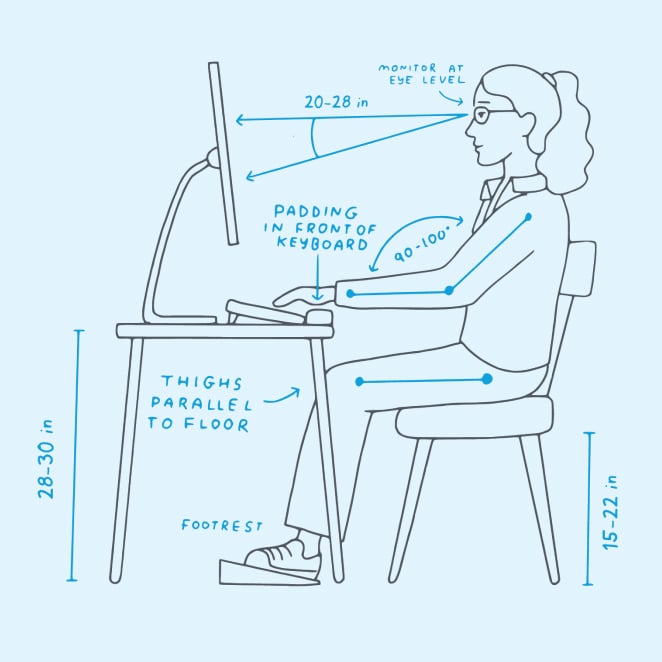Computer vision syndrome, also known as digital eye strain, is a set of vision- and eye-related symptoms resulting from prolonged screen usage.
These days, you don’t have to look very far to find concerning screen-time statistics. We’re told that people are spending eight hours a day looking at some kind of digital media, that a third of Americans say they’re “almost constantly online,” and that we may spend a grand total of 44 years of our lives in front of screens.
But does looking at screens affect your eyesight?
The short answer is yes. As we increasingly depend on computers, tablets, smartphones, and other devices, more and more people are experiencing a condition called computer vision syndrome.
Who’s at Risk for Computer Vision Syndrome?
If you’re logging two or more hours of screen time a day, then you may already be familiar with CVS symptoms.
Computer vision syndrome can lead to blurry vision, sore eyes, and a host of other problems. Its consequences aren’t limited to your eyes—it can also cause pain elsewhere in the body and diminish your work productivity.
What’s more, digital eye strain doesn’t discriminate based on age and can affect children as well as adults.
What Causes Digital Eye Strain?
When you’re staring at your computer screen, it may feel as though your eyes are largely at rest. But in fact, they’re working hard to maintain the right state of focus.
Because text and visuals on a screen consist of pixels—small units of light, glowing with varying intensities—it’s tough for your eyes to settle into a single focused state. Instead, they often switch between concentrated focus on the screen and a less effortful state of focus called the resting point of accommodation.
Reading letters on a printed page doesn’t require the same amount of effort. The crisp, black letters on the uniformly white paper are easier for your eyes to discern, due to their clear contrast. Not to mention, a page doesn’t have disruptive features such as a flickering, reflective surface and glare.
So, when you’re dealing with screens, your eyes are flexing in and out of different focus levels, essentially getting a strenuous workout.
You’re also looking back and forth and up and down as you read. You might be consulting other materials that aren’t on the screen, too, which brings a new level of focus to the game.
Finally, studies have shown that you don’t blink as much when looking at screens (per the University of Iowa, you blink 66% less!). Because they’re not getting moistened as frequently as they’re used to, your eyes might experience dryness, irritation, and slightly blurred vision.
Knowing all of this, it makes sense that the muscles inside and around your eyes would become fatigued after extended screen time. That’s digital eye strain.
Other Risk Factors for Computer Vision Syndrome
The unique properties of screens might cause computer vision syndrome, but other factors can exacerbate it.
Inadequate lighting: A poorly lit environment can increase the strain on your eyes as you work on your computer.
Distance from the screen: If your screen is too close or too far away, your eyes will naturally work harder to help you see what’s on it. For most people, computer screens should sit about two feet—20 to 28 inches—away from your face.
Body position: A hunched posture, a chronically tilted head, tight shoulders—all of these can both stem from and contribute to digital eye strain, creating a distinctly uncomfortable feedback loop.
Uncorrected vision: If you have vision problems that haven’t been addressed by corrective lenses—prescription glasses or contacts—then your digital eye strain symptoms can be especially pronounced.
Computer Vision Syndrome Symptoms
Digital eye strain may cause any or all of the following symptoms:
- Headaches
- Tired, sore eyes
- Difficulty focusing your eyes
- A burning or itching sensation in your eyes
- Red eyes
- Teary eyes
- Dry eyes
- Blurred or double vision
- Neck, shoulder, and/or back pain
Computer Vision Syndrome Treatment
So, can you “fix” computer vision syndrome?
If you’re someone who recognizes these symptoms and wants to know how to treat digital eye strain, we have good news: There are indeed proven strategies for reducing or eliminating its effects.
Computer Glasses
Specialized eyewear can make a big difference in your experience of digital eye strain. One option is computer glasses, which have built-in magnification based on the distance between your eyes and your screen.
Computer glasses are a bit like reading glasses in that they’re meant for this one task—focusing on a screen roughly two feet away from you. However, you shouldn’t ever use computer glasses and reading glasses interchangeably.
For one thing, the two types of glasses are designed to address different scenarios. You don’t hold your book a full two feet in front of your face, right? Computer glasses commonly have about 60% of the magnification power of reading glasses so that they can target that specific, intermediate distance.
Computer glasses also have additional properties that make them even more equipped to fend off computer vision syndrome. For example, their lenses often have anti-reflective, anti-glare coating.
Considering getting some computer glasses? Your eye doctor is the best person to consult. If you tell them about your digital eye strain symptoms and your office setup (including the exact distance from your face to your screen), they can determine the right amount of magnification needed. They’ll also be able to recommend lenses that work well with your existing eye prescription.
Contact Lenses Designed to Help with Eye Strain
If you’re a contact lens-wearer, look into lenses that have been designed for our digital world.
ACUVUE® OASYS 1-Day contact lenses, for example, have been shown to be especially comfortable for people who use digital devices for 8+ hours in a day, and Biofinity Energys help eyes to easily transition between screen use and other activities.
The 20-20-20 Rule
The 20-20-20 rule is an easy guideline to keep in mind during your workday. Simply pause every 20 minutes to look at an object approximately 20 feet away, and hold that gaze for 20 seconds. That’s it!
The 20-20-20 rule gives your eyes a break from the intermediate focusing they have to do on your screen, and offsets the effects of computer vision syndrome. We recommend getting yourself a 20-20-20 mascot, like a stuffed animal or a painting, so that you always have a reminder and a target for the exercise.
Vision Therapy
If your eyes hurt from looking at your computer screen, and their muscles are having an unusual amount of trouble coping, then your optometrist may recommend vision therapy. These exercises can train your eyes to focus and synchronize more effectively.
Other Preventative Methods
With some simple adjustments to your study or workspace, as well as an ongoing dedication to eye care, you can prevent computer vision syndrome from impacting your life and productivity. Here are some strategies to try, in addition to the recommendations above:
- See your eye doctor regularly. Regular eye exams will keep your peepers in top-notch shape and allow you to ask your doctor questions about computer vision syndrome. Today’s optometrists are well-versed in the effects of digital eye strain and can customize a treatment or prevention plan to your needs. Read more: How Often Should You Get an Eye Exam?
- Monitor your screen usage. Yes, the monitor pun is intentional. But in all seriousness, keep track of how long you’re staring at your computer screen each day, and note when you feel discomfort. Take breaks and reduce your screen time when possible.
- Check your computer settings and watch for glare. You can adjust the brightness, contrast, text size, and other aspects of your screen to make its display easier on your eyes. Cut glare by turning your screen away from windows and light fixtures, or investing in an anti-glare filter for your monitor.
- Keep an eye on your ergonomics. Everything from the height of your chair to the tilt of your computer screen can make a difference to your eyes and body. Make sure that your screen is sitting just below eye level at that intermediate distance of about two feet away. Your feet should be flat against the floor, and your posture should be relatively straight, not hunched.






